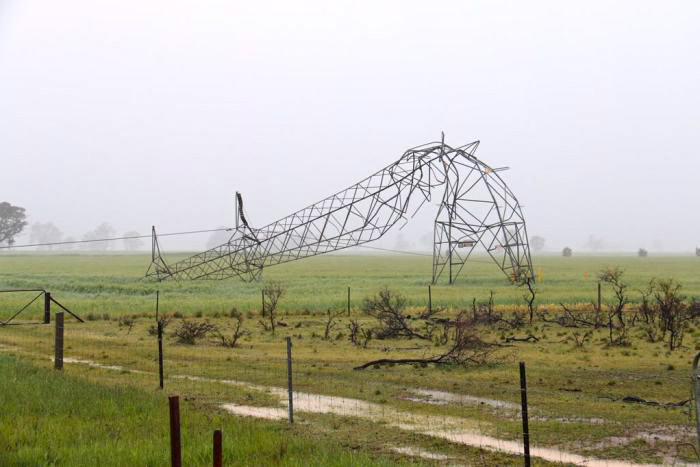The Coalition’s combative approach to energy policy is getting us nowhere.

After the storm: the remains of a transmission tower north of Adelaide. PHOTO ABC
Extreme weather is a fraught business. The fact that it can kill us and destroy homes and crops and infrastructures is reason enough to become anxious when it descends on us.
Add to that man-made greenhouse warming. Of all its predicted outcomes – including rising sea levels, warmer nights and changing rain patterns – extreme weather is by far the most disputed.
Arguments were bound to erupt in the chaotic wake of the big Southern Ocean storm front that swept across settled parts of South Australia late last month, but no-one could have predicted how ferocious they would become.
What made this storm exceptional was the damage it did to the state’s electricity network and the state-wide power blackout that resulted. Prime minister Malcolm Turnbull was so consumed by this the next day that he forgot to mention people’s enduring distress in the continuing emergency.
For many the distress will continue for some time yet. It can take months to even begin to repair severe wind and flood damage, as thousands of 2016 victims from every state can genuinely attest. Full recovery, if it happens, can take years.
It’s time to stop quibbling over whether storms and flooding are getting worse. Reinsurers have complained for years that they’re causing more damage than they used to, and science has identified multiple examples of rising intensity and frequency of extreme events.
Even the most unscientific energy minister should be able to grasp the physics behind this. A warmer ocean is a more energetic one, able to contribute more energy to storms, while a warmer atmosphere can hold more moisture and result in more high-rainfall events.
Electricity blackouts support the view that extreme events are on the rise. Last year a US study showed that country’s 2014 power outages, which according to the US energy department are caused mainly by severe weather, were four times higher than in 2000.
A similar picture – more extreme weather driving more outages – emerges from Australian and New Zealand data published last year by Eaton Industries, including rises over just one year (2013 to 2014) of 24 per cent in the number of outages and 37 per cent in their duration.
Another disruptive factor, discussed at length in Friday’s energy ministers conference called by federal energy and climate change minister Josh Frydenberg, is the grid’s physical and technical capacity to deal with the kinds of stresses now being experienced.
Both Frydenberg and his leader allowed that the South Australian blackout was primarily caused by the storm, but both also added that the intermittency of wind energy coupled with an “aggressive” state renewable energy target threatened the stability of the state’s power supply.
Frydenberg persisted with that line of argument after the Friday meeting, characterising South Australia’s high level of renewable energy as “a big experiment which failed”.
Some over-eager commentators found “evidence” for such claims in a preliminary report by the Australian Energy Markets Operator that identified loss of output from wind generators just before the interconnector carrying Victorian power switched itself off and blacked out the state.
But the report did not identify any inherent instability in wind power and was careful to warn against forming conclusions before further analysis is done.
In any event, Turnbull’s stated order of priority for the national electricity market (grid stability first, followed by affordability followed by reduced emissions) is a fool’s choice.
Of course we need and expect reliable, affordable power. But what kind of thought process would assign it a higher priority than a stable climate, and what does it say about the PM’s seriousness in Paris last December when he committed Australia to the huge task of securing that goal?
The main outcome of last Friday’s energy ministers’ meeting – a direction to the chief scientist, Alan Finkel, to draw up a plan for long-term energy security, affordability and sustainability – is a nod in that direction. His interim report due in December will be eagerly awaited.
Frydenberg saw the outcome as prioritising energy security, but there’s no getting around the imperatives hanging off the Paris Agreement. Whatever else it does, Finkel’s plan is going to have to incorporate practical steps for decarbonising the electricity market.
One more curly question arises out of the South Australian experience. State renewable energy targets fade almost to insignificance compared to the need to resolve the mishmash disarmingly called the national energy market.
Australia’s electricity “system” isn’t really a system at all, but a rough and incomplete amalgam of formerly self-contained state grids linked by a handful of inadequate interconnectors. In Victoria and South Australia those grids are privately owned.
Privatisation has not brought down power prices, but it has raised questions about market manipulation. A notable example of that was in July when the price of South Australian gas-fired power jumped to nearly $9000 a megawatt hour because the market mechanism allowed it.
Every energy minister must strive to ensure grids are as stable and storm-proof as humanly possible. That calls for better engineering and improved system integration across state boundaries, but it also calls for much more rigorous public administration.
And underlying all that is the ticking time bomb of climate change. After years of leaning, as Joe Hockey might put it, Australia has to start lifting, and the main target remains the biggest polluter, coal-fired electricity.
If the world fails to turn around a rising emissions trajectory, the most robust power systems in the world will likely prove unable to withstand the fury of mother nature.
